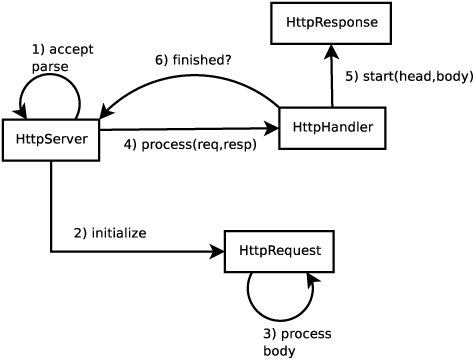Section 6.1. Mongrel s Architecture
6.1. Mongrel's ArchitectureWhat makes Mongrel so extensible is its simplistic architecture that gets the job of cooking and shuttling HTTP requests around the system done. Mongrel would probably make the Enterprisey folks scream since it is obviously too simple to scale. Ironically this simplicity is exactly why Mongrel is fast and scales, but it's also your secret weapon when extending and embedding to your own crazy ideas. Zed Sez Simpler always wins when you are writing software. I didn't say "simplistic" but "simpler," meaning when compared to another solution. I find that too often programmers get too caught up in building grand palaces of crystal and gold with incredibly intricate inner workings. They love impressing their friends with the equivalent of the "SUV" of software architectures and the more boxes, lines, and color in the diagram the better. Even better if it has to go on multiple walls. What we have now is a crisis where the coders of the world value complexity and intricacy over simplicity and directness. They would rather build a "Rube Goldberg Architecture"[9] full of indirect puzzles that interact in a chain to accomplish nearly nothing. They then wonder why their software is buggy, crashes, has security holes, and requires a coterie of 10 developers to gather before it works.
I've always had a different aesthetic sense when I write my software. I value simplicity and directness and try to write software that follows this approach. I jokingly call it the Shibumi School of Software Structure. All I do is apply this rule: When given two possible designs with equal end results, pick the simpler one. I then ruthlessly strip the solution down to its finest elements, but no more. Keep this in mind when you've got an architecture or solution designed that you feel is fantastic. Are you actually impressed with the solution or its complexity? Are you sure there's not a simpler way to do the same thing, even if it seems "ugly"? Is it possible that all the people who told you this is how software is designed are wrong? These are the types of questions developers should be asking. Until they do, we're just going to get larger and larger architectures that don't really do anything. Rube would be proud. Mongrel's architecture is composed of the following key players:
That makes up the main classes being used. Yes, that's all of them. There are a few others that help setting up new handlers, help package them as plugins, etc. but you can get by with just these five, and actually you don't have to know how HttpServer and URIClassifier work. How all of these classes work together is best illustrated in Figure 6.1. Figure 6.1. Mongrel Request Processing The only thing missing from this diagram is that HttpServer does this for chains of handlers that are registered at different URI paths. To make sure you understand the diagram, we'll go through a typical request.
The only missing piece is how the HttpServer knows which handler gets which requests. As mentioned in the list of important classes, URIClassifier keeps a mapping of all paths and the HttpHandler chains that are responsible for processing them. HttpServer just looks them up in URIClassifier like a hash map and it's done. You actually won't work with this directly except for simple registration calls through Configurator#uri. 6.1.1. DocumentationNow that you understand Mongrel's deceptively simple architecture, you should take a quick break to browse through the Mongrel Web site's RDoc documentation. Much effort was put into documenting every class in Mongrel so that developers can be self-sufficient. You can find Mongrel's documentation at the Mongrel RubyForge RDoc pages (http://mongrel.rubyforge.org/rdoc/). |
EAN: N/A
Pages: 48

